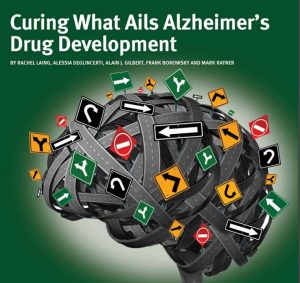 Developing an Alzheimer’s disease drug has been notoriously expensive and high risk. Part of the problem has been the difficulty in identifying the right patients for clinical trials and at the right time – that is, those patients showing early signs of cognitive impairment who will progress to AD. However, new diagnostics, biomarkers, and digital tools for cognitive assessment are beginning to emerge, as we’ve detailed in our recent In Vivo publication, “Curing What Ails Alzheimer’s Drug Development.” Use of these tools will be key to winning the race to a successful AD drug, as they will be essential to select patients for clinical trials, measure meaningful responses to new drug therapies, and ultimately, guide an approved drug’s clinical usage.
Developing an Alzheimer’s disease drug has been notoriously expensive and high risk. Part of the problem has been the difficulty in identifying the right patients for clinical trials and at the right time – that is, those patients showing early signs of cognitive impairment who will progress to AD. However, new diagnostics, biomarkers, and digital tools for cognitive assessment are beginning to emerge, as we’ve detailed in our recent In Vivo publication, “Curing What Ails Alzheimer’s Drug Development.” Use of these tools will be key to winning the race to a successful AD drug, as they will be essential to select patients for clinical trials, measure meaningful responses to new drug therapies, and ultimately, guide an approved drug’s clinical usage.
The hard work of validating biomarkers and digital assessment tools, and building a clinical practice infrastructure has only just begun. Once well-validated screening and diagnostic tools, as well as new treatments, are available, their successful clinical use will depend on considerable education of both physicians and payers. As it is conceivable that a new disease-modifying treatment may emerge within the next five years, we believe it is time to prepare for an emerging Alzheimer’s disease market now.
We believe the best chance for success is for drug makers, diagnostics companies, and the developers of digital health tools to work together to generate a screening paradigm for patients that will increase the odds of clinical success and pave the way for commercialization.
Such partnerships bring a number of advantages to companies on all sides of the partnering equation. They help pharma companies recruit the right patients for clinical trials, reduce trial costs, differentiate their products in a crowded space, generate key data and endpoint measurements, support payer negotiations upon approval and launch, and overall mitigate risk. Diagnostic companies, in return, gain access to the patient data needed to validate their tests, link their test’s clinical utility with treatment outcomes, generate the clinical data needed to support test approval, may leverage pharma resources to secure test reimbursement, and raise awareness and adoption of the tests by the medical community as part of primary care patient evaluations.
Partnerships between pharmaceutical and diagnostic companies have been quite successful in areas like oncology, where the concept of “precision medicine” has now become a central part of drug development. As precision medicine expands to the CNS space, we believe we are poised to see a wave of transformation and innovation that will likely lead to better treatments and, ultimately, improved patient outcomes for Alzheimer’s disease and other CNS illnesses.